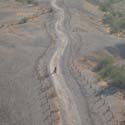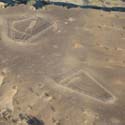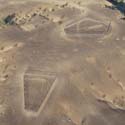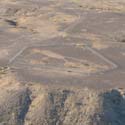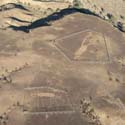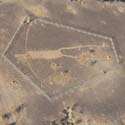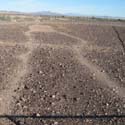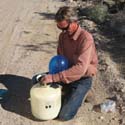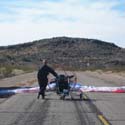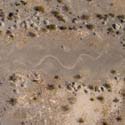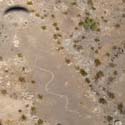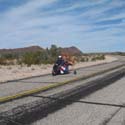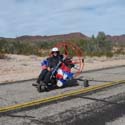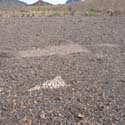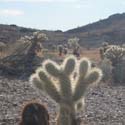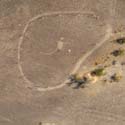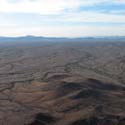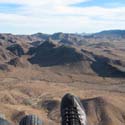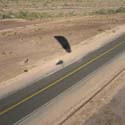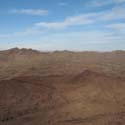The Blythe Intaglios
In 1931, George Palmer, a local pilot, discovered these huge figures outstretched across the desert pavement on the terraces above the Colorado River near Blythe, California. Archaeologists call these kinds of earth figures "geoglyphs" or "intaglios" (in tar yoe).
Geoglyphs can be found in three forms: one is where designs or features are created by aligning stones together; another method involves the scraping away of the desert pavement gravels exposing the ligher colored sands to create the designs or features; and finally the designs or features are tamped into the desert pavement forming an indented image. The "Blythe Intaglios" were created by scraping away the desert pavement.
Archaeologists cannot be sure how old the geoglyphs are, since dating techniques have not been developed to date these types of features. According to Native American oral histories, the human figure may represent the Creator, while the animal figures may represent mountain lions who helped in the creation.
The human figure is oriented north-south with its head pointing toward the south. Its arms are outstretched and its feet point outward. It measures 105.6 feet from head to toe. The torso combined with the arm span are 91.8 feet wide. It has visible knees and elbows.
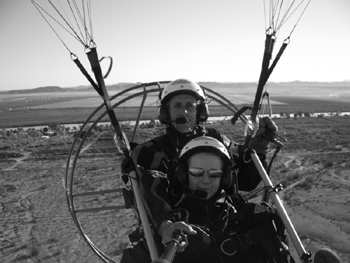 The animal and spiral figures that are represented here are may be mentioned in Native American histories as mythological characters. Their stories mention the mountian lion who changes into a person and helps the Creator with the earth. Some non-Native Americans believe the figure represents a horse, which would date the site to post Spanish visitation of the area. The animal and spiral figures that are represented here are may be mentioned in Native American histories as mythological characters. Their stories mention the mountian lion who changes into a person and helps the Creator with the earth. Some non-Native Americans believe the figure represents a horse, which would date the site to post Spanish visitation of the area.
The animal figure is oriented northwest-southwest with its head pointing toward the northwest. It measures 54.1 feet from head to tail and its body is 7.5 feet wide. Its legs measure 26.2 feet long and at the end of each leg is a half circle, interpreted to possibly represent a paw or a hoof.
Below the animal figure is an elaborate spiral figure. It measures 23 feet in length and is oriented northwest-southwest and has a maximum width of 8.8 feet. One interpretation is that the figure represents a coiled snake. Is the mountain lion battling a snake?
Earlier drawings indicated fingures and toes and several lines are coming out from the head. Could they represent strands of hair atop the head? Today these subtle parts of the figure are difficult to discern. This figure is one of the least disturbed of the group.
The other human figure most likely represents a male; it is the only one of the "Blythe Intaglios" that appears to have originally been created with a phallus between its legs. The figure measures 102.0 feet from head to toe, and its arms span a distance of 64.9 feet. Its left leg is pronouncely flexed. It lacks defined knees, but does have clearly defined elbows. There are no visible fingers or toes.
The third pair of figures is much larger, with the human figure measuring 171 feet in length. The human figure is about twice the size of the others, and also seems to have a phallus design, although this could have been added by later "artists". The animal figure clearly has a long tail like a mountain lion.
According to Mohave and Quechan tribes of the lower Colorado River area, the human figures represent Mastamho, the Creator of Earth and all life. The animal figures represent Hatakulya, one of two mountain lions/persons who helped in the Creation. In ancient times, sacred ceremonial dances were held in the area to honor the Creator of life.
The elongated human forms probably represent the creator and his evil twin, key figures in the creation beliefs of modern native people in the region. The animal figures invite various interpretations. Some people say they look like horses, albeit with very thin tails. Of course, traditional thinking proclaims the Spanish introduced horses to the New World. Could the animal figures be cougars, powerful creatures in the old legends? Some visitors think they discern fearsome claws at the ends of the creatures' thin legs, all but erased by time. The figures continue to cause speculation since their tantalizing mystery remains to be unraveled.
The Bouse Fisherman Intaglio or Geoglyph tells an important story. Native Americans of the lower Colorado River Region have oral traditions which were handed down through generations. This Geoglyph may tell the mythological story of a God, Kumastamho, who thrust a spear into the ground to make the mighty Colorado River Flow. The people who rendered this geoglyph used white quartz to accentuate his spear. White quartz is a very sacred rock to the people of this region.
There is some controversy surrounding the creation of the "fisherman" Intaglios located northeast of Quartsite, Arizona. Some say that it may be attributed to local Colorado River Indians and it was created within the last 70 years. Many intaglios have been dated to over 5,000 years ago. Another possibility of the creator of the image would be that it was made by an “Avant-guard” artist who decided to sculpt the floor of the desert. The meaning behind the “fisherman” is explicitly detailed and is said to be Kumastamho the Creator. Legend says that Kumastamho drove his spear into the Rocky Mountains of Colorado to answer the prayers of his people for water. He is likewise attributed to carving the course of the Colorado River with his spear; the water flowed towards the home of the Yuman-speaking tribes. This was their myth regarding the creation of the Colorado River.
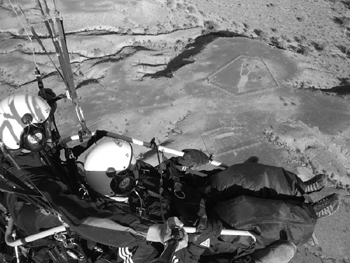 Geoglyphs are classified as rock art, which also includes pictographs and petroglyphs. Pictographs are rock paintings while petroglyphs are rock engravings. Pictographs are generally found in coastal mountain ranges while petroglyphs are more often found in the desert. Intaglios are often located near the Colorado River. Geoglyphs are classified as rock art, which also includes pictographs and petroglyphs. Pictographs are rock paintings while petroglyphs are rock engravings. Pictographs are generally found in coastal mountain ranges while petroglyphs are more often found in the desert. Intaglios are often located near the Colorado River.
The ancient artists used desert areas where wind scours away loose sand, leaving the ground paved with a layer of stones. Little grows on this desert pavement as the wind blows seeds away, too. Over time, the natural mosaic acquires a dark coloration known as desert varnish caused by manganese and other elements in the dry air, a process scientists can now measure.
To create the mythic figures, the ancient people scraped away the desert pavement to expose the lighter earth below. They outlined the symbols by heaping rocks pulled away from the center around the outside edges creating sunken designs called intaglios after an early Italian form of engraving. Experts calculate the natives created the Blythe Intaglios about 1,100 years ago. Some intaglios are old enough that the desert varnish has begun to reappear.
Perhaps geoglyphs are just another variation on art form. Wherever man has found a plentiful and reliable food source, he has ended up with a surplus of time on his hands. Time translates into artistic expression. This is common occurrence throughout the history of civilization.
A variety of theories surround the origin and significance of the giant desert figures. Theories include religious lore and cultural expressions from the Indians, territorial markers or astronomical graphics. But one author uses the giant figures, found nowhere else on the continent, as evidence for his theory that primitive man was at one time visited by highly intelligent beings from outer space. Eric Von Danagen, in his A Chariot of the Gods and the movies that followed its release during the early 1970's, theorized that man was visited while the planet was relatively young and homo-sapiens were primitive.
He claims that the giant desert figures can be seen only from the air where the original calculations for the proportioned geoglyphics were made and given to the Indians below who followed the instructions in carving out the figures, scraping as deep as six inches into the rocky desert floor. He added that the figures can be seen from the ground, but make sense only when viewed from the air, and were possibly some sort of landing guide for the extraterrestrial visitors.
Archaeologists can't agree on how old the Intaglios may be. Perhaps hundreds, perhaps thousands of years. Their age could be more than 2000 years, but they are at least 450 years old. Reportedly, there are over 600 Geoglyphs in these deserts, but these are the largest and most visible. Many have withstood the test of wind, rain and time, others having fallen recent victim to motorcycles, SUV's, quads and General George S. Patton's tank-training exercises during WWII.
It is obvious that these images were not created for the enjoyment of man, but were created for the enjoyment of the gods. " …They were not created for the viewing of critical mortals." Due to their massive size, "geoglyphs generally are simple and characterized by irregular lines and proportions." Boma Johnson, an archeologist for the Bureau of Land Management in Yuma, Arizona said he could not "think of a single [intaglio example] where [a person] could stand on a hill and look at [an intaglio in its entirety]."
From the ground, these figures are nearly unnoticable, as can be seen in the photos. From the air, they are clearly obvious. Many questions still arise after observing these figures scraped into the desert. What do they represent? Why were they put here? Who created them? When were they done? What do you think?
Read Greg Bishop's Blog here. |
